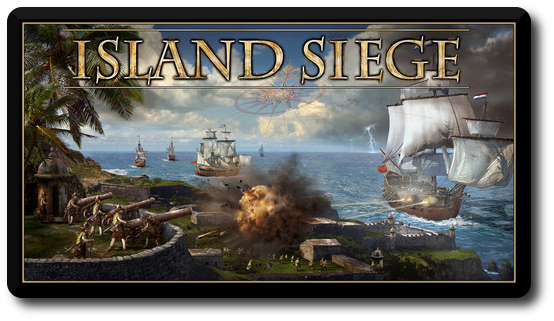
The Basics:
- For ages 9 and up (publisher suggests 13+)
- For 2 players
- Approximately 45 minutes to complete
Geek Skills:
- Counting & Math
- Logical & Critical Decision Making
- Reading
- Pattern/Color Matching
- Strategy & Tactics
- Hand/Resource Management
Learning Curve:
- Child – Easy
- Adult – Easy
Theme & Narrative:
- Build, populate, organize, and defend your settlements in the New World!
Endorsements:
- Gamer Geek approved!
- Parent Geek approved!
- Child Geek approved!
Overview
The voyage to the New World was fraught with danger and death. When the colonists arrived, they thought the worst was behind them. They were wrong. They are now under attack and they must quickly build forts with strong walls to protect their homes and lives. These are dangerous and desperate times and it’s up to you to lead your colonist. Victory can only be obtained through military or economic might. Choose your path.
Island Siege, designed by Dan Manfredini and published by APE Games, is comprised of 18 Colonist meeples (9 per player), 27 cubes (9 black, 9 grey, and 9 white), 2 Fleet meeples (1 per player), 4 custom six-sided dice, 8 “One” coins, 3 “Five” coins, 2 “Ten” coins, 2 Imperial cards (1 per player), 2 Starting Fort cards (1 per player), 18 Fort cards, 6 Ship cards, 12 Building cards, and 2 Reference cards. The meeples and cubes are made of wood. The cards are durable and as thick as your standard playing card with the exception of the Imperial cards which are much thicker and bigger. The dice are made of plastic. The coins are made of metal and come in different shapes and weights. Excellent component quality for such a small 2-player game.
Game Set Up
Note: Prior to playing the game for the first time, the game’s owner will need to affix stickers to the 4 six-sided dice. This is not difficult, but should not be rushed to ensure it’s done properly.
To set up the game, first give each player 1 Imperial card, 1 Starting Fort card, 9 Colonist meeples of the same color, and 1 Fleet meeple that matches the color of the Colonists. Players should place these components in front of them.

Imperial Card
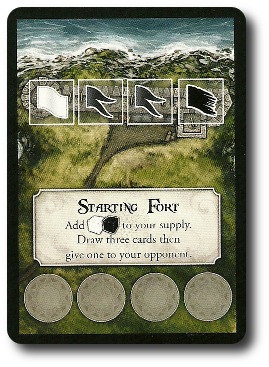
Starting Fort Card
Second, place the coins and cubes to one side of the gaming area. This is the game’s coin and cube pool for the duration of the game. Give each player 1 “black” cube, 2 “gray” cubes, and 1 “white” cube from the pool. These cubes are placed on the matching flag icon colors on the player’s Starting Fort card. Additionally, each player takes 1 “black” and 1 “white” cube to create their initial supply. These cubes are NOT placed on the player’s Starting Fort.
Third, each player should place their Colonist meeples on their Imperial card. There are three sections on the Imperial card’s right side. Three Colonist meeples should be placed in each section. The Fleet meeple should be placed to the upper left on the Imperial card.
Fourth, shuffle the remaining Fort and Ship cards together to form 1 deck. Place this deck, face-down, next to the coin and cube pools. This is the game’s draw deck for the duration of the game.
Fifth, each player draws 3 cards from the draw deck, keeps one, and passes the remaining 2 to their opponent.
This completes game set up. Time to colonize the New World!
Veni Vidi Vici
Island Siege is played in rounds and turns with no set number of rounds per game. On a player’s turn, they are referred to as the “active player”. The active player will complete a small number of sequential phases and steps to complete their turn. The phases and steps are summarized here.
Phase 1: Check for Victory
The very first thing a player does on their turn is determine if they won the game. See “Winning the Siege” below for details on victory conditions.
Phase 2: Colonize
The second phase allows the active player to place 1 Colonist meeple from their Imperial card to each of their Fort cards. Colonist meeples are taken from the bottom most row first, then the middle row, and finally the top row. When a row on the Imperial card no longer has any Colonist meeples located on it, the player is granted a special ability. This same ability is lost if a Colonist meeple is returned to the Imperial card and occupies a previously empty row.
Note that Colonist can only be placed on a Fort card if there is an empty space. If there are none to be had, this phase is skipped.
Phase 3: Take Action
The third phase allows the active player to take up to 2 actions (1 mandatory and 1 optional).
Mandatory Action: Return Fleet Meeple
If the player has launched their Fleet meeple from their Imperial card in a previous turn (which indicates they attacked their opponent during the last round), they must first return it to their Imperial card before taking any other action.
Now the active player must select 1 optional action to take.
Optional Action: Draw Cards
This action allows the active player to draw 3 card from the draw deck, choose 2 to keep, and give the remaining card to their opponent. All cards are kept in the player’s hand (there is no hand size limit). If the draw deck is exhausted, simply shuffle the discard pile to create a new draw deck. The active player’s turn is now over.
Optional Action: Build 1 Fort, 1 Ship, or 1 Building Card
This action allows the active player to build 1 Fort, 1 Ship, or 1 Building card from their hand. One and only one can be selected.
- Build a fort by placing it face-up in front and adding 1 colored cube from the cube supply that matches the flag color. Any cubes in the player’s personal supply can now be added to any open space or left empty at this time. The player then collects coins equal to the number of cubes they used from their personal supply. The free cube is NOT counted.
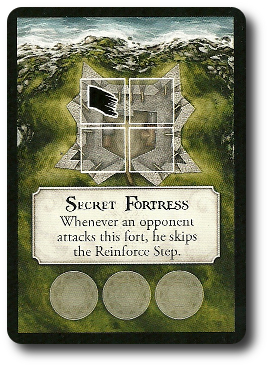
- Build a ship by placing it face-up in front and adding a number of Colonist meeples from 1 Fort card equal to (or greater) than the number of Colonist meeples require to sail it. These colonist are moved to the Ship card. The player then collects coins equal to the number shown on the Ship card.

- Build a building by placing it face-up next to a previously built Fort card and adding a number of Colonist meeples from that Fort card equal to the number of Colonist meeples required to use the new building. The player then collects coins equal to the number shown on the Building card. New buildings can also repair forts. A cube and color is shown on the Building card. This is collected and added to an empty space on the Fort card as soon as the Building card is built.
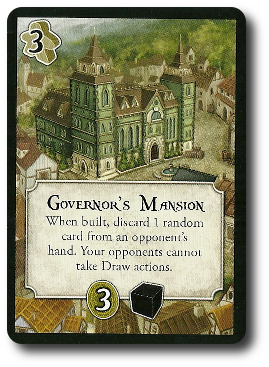
After the active player builds 1 Fort, 1 Building, or 1 Ship, their turn is over.
Optional Action: Attack 1 Fort
This action allows the active player to attack an opponent’s Fort card. It’s not a complex process, but requires its own section. After the player attacks an opponent, their turn is over.
Attacking Forts
If the active player selects the optional action to attack, they first take their Fleet meeple and place it in front of an opponent’s Fort card they want to attack. The active player then takes the dice and rolls them. Depending on how many Colonist meeples the player has cleared from their Imperial card and what Forts, Ships, and Buildings they have in play, they might be able to re-roll the dice one or more times. After the active player is done rolling the dice, the attack is resolved by following a few sequential steps.

Possible dice results from left to right: Wheel (Leadership), White Flag, Grey Flag, Grey Flag, Black Flag, Bang
Step 1: Leadership
The Imperial card and some Ship cards allow the player to use special leadership abilities. These can be used or not, depending on the player’s preference. However, the dice must have the symbol shown on the card or they are not available.
Step 2: First Wave
The active player now chooses 1 flag color (which corresponds to cube colors on an opponent’s fort) that appears on at least 1 of the dice. If a red “Bang” or white “Wheel” are the only rolled results, this step is skipped.
The opponent must then remove 1 cube per dice that matches the flag color selected. Removed cubes are returned to the cube pool. Depending on how the cubes are placed on the Fort card, the fort itself can be tricky to take down. Players can organize their cubes by color on their Fort cards to protect cubes. “Connecting” them by way of being adjacent to each other makes the walls of the fort stronger, and as a result, it takes more than 1 hit to remove a single cube. Refer to the game’s rule book for an in-depth explanation of the different ways a player can build their fort walls. Here are two examples of how proper cube placement can make a simple little fort into an impregnable fortress.
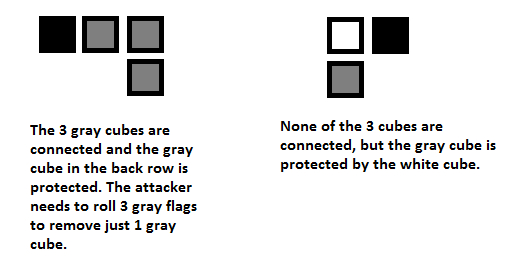
In summary, if cubes of the same color are parallel to each other (horizontally or vertically), they are considered “connected”. The number of connected cubes determines the number of flags of that cube color that must be rolled (or higher) during the first wave of the attack to remove a single cube. Cubes that are behind any other cube in the same column are considered “protected”. Protected cubes cannot be targeted during the first wave of attacks if there is another cube in front of it.
Note that during the second wave, cube color and placement is no longer taken into account.
Step 3: Reinforce
The active player can now add 1 cube to their personal cube supply for each remaining die that was not used in the attack. The cubes must match the flag colors. If there are no free flags or the cube colors that match the available flags are not available in the cube pool, this step is skipped. The active player can also decide to skip this step so they can attack their opponent a second time.
Step 4: Second Wave
This step is only available if the player decided not to (or couldn’t) reinforce. For each red “Bang” result, the active player removes ANY 1 cube from the fort they are attacking. Unlike the first wave attack where the cube placement makes the fort more difficult to remove, the second wave beats through a fort’s defenses and pummels it to the ground.
Step 5: Destruction
If the fort being attacked no longer has any cubes, it’s destroyed. The Fort card and any attached Building cards are discarded. Any Colonist meeples located on the Fort and Building cards miraculously survive and are returned to the player’s Imperial card (filling the top most rows first and filling down).
Attacking at Sea
If an opponent doesn’t have any Fort cards in play, they can still be attacked. This is referred to as “attacking in open waters”. The active player declares their attack as normal, but does not place their Fleet meeple. They then take the dice and roll them and re-rolls them as necessary. Only the Leadership and Reinforce steps are played.
Special Abilities
As previously noted, the Imperial card provides the player with special abilities when they empty Colonist meeple rows. Fort, Ship, and Building cards also provide special abilities. The use of these special abilities is dependent on if the current situation allows it. For example, the “Governor’s Mansion” Building card allows the active player to discard 1 random card from their opponent’s hand and then blocks their opponent from drawing new cards! That’s pretty powerful and is sure to make the fort that houses the Govern’s Mansion a HUGE target for cannon fire.
It’s up to the player to keep track of the special abilities their cards provide and in which phase (or player’s turn) they should be used.
Winning the Siege
There are two ways to win the game. A player can attempt to win through colonization or economic might. The game ends during the first phase of a player’s turn if the active player has completed any of the following:
Colonization Victory
The player wins if all their Colonist meeples are off their Imperial card.
Economic Victory
The player wins if they have 20 or more coins (value, not actual physical coins) AND they have more coins than their opponent.
Game Variant
Island Siege is playable by 2 people right out of the box. The game can be expanded to 3 to 4 players if a second game is combined.
To learn more about Island Siege, visit the game’s web page.
Prediction
I predict good things from this game and a high level of approval from all our groups. The game play is simple, but the choices the player needs to make is not. I would normally be concerned about players becoming locked up in a state I referred to as “vapor lock”. Others call it “analysis paralysis”. But I don’t think that’ll be the case here. There are most certainly difficult choices to make, but the player only get to make 1 choice per turn. This should keep the vapor locking down to a minimum.
Another aspect of the game I think that will do very well is the fortification of Fort cards. What a neat and elegant way to use cubes! Each Fort card has a slight variation of multiple boxes that serve as cube placement guides. Coupled with the pre-set initial cube placement, the player must keep their own cube supply as diverse as possible to accommodate and take advantage of the cubes that can be placed.
Yes, I think this game will do very well and it shouldn’t be difficult to teach, either. I suggest you focus first on the cube placement and then combat. If a player doesn’t protect themselves, all their building will soon end in ruin. A quick demonstration should be all that is necessary. Note that the game does use simple math and requires reading in order to play.
And so, after teaching the game to my oldest little geek, I asked him his thoughts on Island Siege so far.
“Looks like a neat little game. I like how you get to build forts, buildings, and ships and then blow all of them up.” ~ Liam (age 9)
Let’s play Island Siege and see if the game is worth getting excited over.
Final Word
The Child Geek rather enjoyed Island Siege and even won a game or two (always through Colonization victory, oddly enough). The biggest beef they had against the game was the forced fork in the road between building and fighting. The Child Geeks liked the idea of combat in the game and how the dice were used, but they didn’t like that they were only able to attack one Fort card at a time. This most likely explains why the Child Geeks heavily favored the building actions. There is much more choice to be had in a small fist full of cards versus a small number of dice. According to one Child Geek, “I really like how I get to build my little world, but I don’t like it when it gets attacked.” Another Child Geek said, “This is my new favorite 2-player game!” All the Child Geeks voted to approve Island Siege.
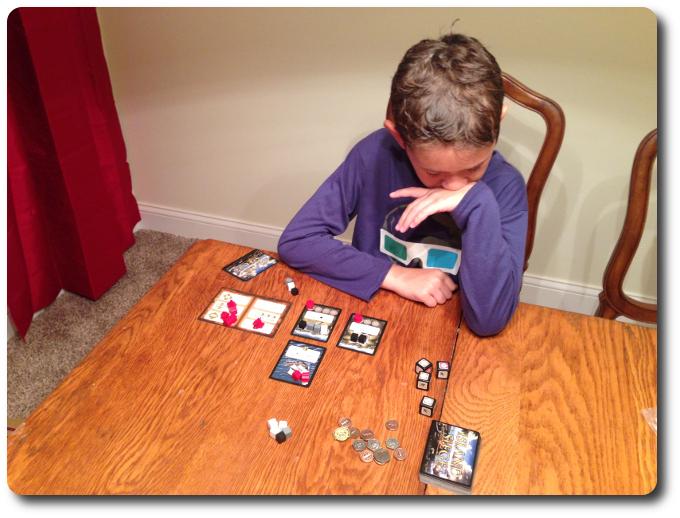
My little geek considers his choices based on his dice rolls
The Parent Geeks really liked Island Siege, but disliked that it was only a 2-player game. According to one Parent Geek, “This is a great game, but the fact that it can only play 2-players is going to keep it off the table when it should be on.” When I told the Parent Geeks that they could buy 2 copies of the game to make it a 4-player game, one Parent Geek said, “Wow, what a scam!” But not all the Parent Geeks thought so. Another Parent Geek said in response, “This is a great 2-player game. If I really wanted to make it a 4-player game, I could. The game is complete as it is. It’s up to me to spend more money if I want to make it a bigger game.” Some Parent Geeks grumbled and some just rolled their eyes. All the Parent Geeks voted to approved Island Siege.
The Gamer Geeks were a bit skeptical at first when I explained the game to them. Admittedly, I left some of the best aspects of the game out of the description as a surprise. Specifically, the proper placement of cubes to build a more heavier fortified fort and the many abilities the cards provided. When the Gamer Geeks saw these two aspect of the game come into play, they were no longer skeptical. In fact, their skepticism was replaced by delight. According to one Gamer Geek, “This is a sold game. Totally solid. Every action is meaningful and sometimes painful to decide!” Another Gamer Geek said, “Excellent 2-player game. It’s light enough to be played casually, but has a great deal of strategy and tactics. I really like it.” All the Gamer Geeks voted to approve Island Siege.
I am very pleased with Island Siege. The dice introduce a slight element of randomness that is countered by critical decision making. The abilities provided by the cards give each player a lot to think about and to do. The game feels big, but plays small. The amount of time you’ll spend in the game is short (less than 1 hour), but the amount of effort you put into the game feels a lot heavier than you’d first expect. It was a delightful surprise and continues to entertain me after many game play sessions.
I would love a chance to play the game with 3 to 4 players. From what I’ve read, the game scales very well. As the game is, it’s very well-balanced, provides a great deal of options, fun decision making, opportunity for strategy, and lots of tactics via card abilities. If I can get all that from a 2-player game, I have high hopes for a 3 to 4 player game. The only decision I need to make here is to decide if I should buy another copy of the game or not. Once again, Island Siege has presented me with a difficult choice! What is not difficult is suggesting this game. Do play Island Siege the very first chance you get.
This game was given to Father Geek as a review copy. Father Geek was not paid, bribed, wined, dined, or threatened in vain hopes of influencing this review. Such is the statuesque and legendary integrity of Father Geek.




Pingback: In Review: Father Geek’s Monthly Newsletter (July 2014) - Father Geek
Pingback: In Review: Father Geek’s Monthly Newsletter (August 2014) - Father Geek